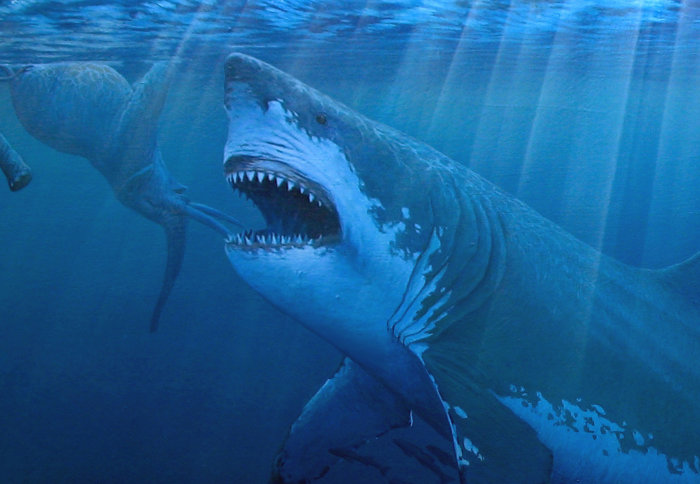
Devourer of Giants: Drowned mammoth is eaten by a giant shark (Charcarocles megalodon) Artwork Copyright © Bob Nicholls/Paleocreations 2000

Q&A with Professor Alan Haywood, past-climate expert, and speaker at an event at Imperial College London about global warming and the Pliocene epoch.
Geological history has much to teach us about the fate of the planet as our climate changes, including future global temperatures and rainfall, polar ice coverage, sea levels, and plant and animal life, as well as conditions for human civilisation.
The concentration of carbon dioxide in the atmosphere has varied wildly over the hundreds of millions of years that the earth has supported life, but the last time it reached 400ppm (parts per million) was during an epoch called the Pliocene, before modern humans had evolved, around 2.7 million years ago by current evidence, and the planet looked very different.
In 2013, the concentration passed this level for the first time in civilised history; a direct result of human activities that burn fossil fuels like coal, oil and gas. Scientists expressed concern that upsetting the delicate balance of our planet's atmosphere was leading to a global warming crisis.
The Royal Meteorological Society and Grantham Institute – Climate Change and the Environment at Imperial College London have come together to host a joint meeting presenting the scientific evidence for climatic conditions during the Pliocene era and discussing its significance for understanding climate change today.
Alan M. Haywood, who is Professor of Palaeoclimate Modelling at the University of Leeds and one of the event's presenters, explains more about the subject.
What is the Pliocene?
The Pliocene is an epoch of geological time that started 5.3 million years ago and ended 2.6 million years ago.
What were climatic conditions like at this time?
Generally, the climate was warmer and wetter than today. Global annual mean temperatures were about 3°C warmer, with temperatures notably higher towards the North and South Pole.
What kind of life was there on Earth?
Many species of plants and animals that are alive today were alive during the Pliocene, so landscapes would be quite recognisable to the modern eye. However, there were many species of 'mega-fauna' (giant animals), such as the giant ground sloth and large sabre-toothed cats. In the oceans there was the ‘terror of the deep’, the Megalodon, a species of giant shark that could grow up to 50 feet long. These species thrived in the warm temperatures.
What was the sea level like in the Pliocene?
Due to the warmth generated by high greenhouse gas concentrations, polar ice sheets were very different to today. We know that global sea level may have been 10-25 metres higher than it is today, which suggests that the Greenland and West Antarctic ice sheets were largely absent, and some of the East Antarctic Ice Sheet may have been lost as well.
How we know this?
By combining decades of detailed geological study, interpreting data from rocky outcrops and marine sediment cores, and integrating these records with climate models capable of simulating many different aspects of the Pliocene climate, scientists have been able to reconstruct a picture of what climates and environments were like millions of years ago.
Why is this different to the modern climate?
A good question! The prevailing paradigm is that temperatures in the Pliocene were higher because carbon dioxide was at a high concentration - over 400ppm - over a long time. Whereas today, carbon dioxide concentrations have risen sharply since the industrial revolution and are yet to have their full effect on temperature. There are also feedback processes that, in the Pliocene epoch, will have amplified the direct carbon dioxide induced warming. An example of this would be the amount of solar radiation reflected by polar ice, which decreases as the ice shrinks, meaning the planet absorbs more of the heat from the sun’s rays, accelerating warming.
Why did carbon dioxide concentration in the atmosphere decline after the Pliocene?
Another very good question! In short, we don’t really know. However, we suspect that long-term geological processes, which determine the amount of carbon dioxide in our atmosphere, may have played a role. These processes change the delicate balance between carbon dioxide emitted into the atmosphere from natural stores deep underground and volcanoes, and carbon dioxide which is removed from the atmosphere when it dissolves in rainwater and reacts with rocks, ending up locked away in the oceans.
What can we learn from the Pliocene about future climate change?
The Pliocene is perhaps the most easily understood geological example of when the climate was in a long-term equilibrium with an atmospheric carbon dioxide concentration very similar to that of today. Scientific evidence about this era informs us how the Earth system responds to elevated concentrations of carbon dioxide in the atmosphere, and about the relationships between greenhouse gases, temperature, ice sheets and global sea-level.
The meeting, "The Pliocene: The Last Time Earth had >400 ppm of Atmospheric carbon dioxide ", is recorded and broadcast on the Grantham Imperial YouTube Channel.
Top image: Devourer of Giants - A herd of mammoths (mastodons) have drowned and are eaten by three giant Pliocene sharks (Charcarocles megalodon) - artist interpretation of underwater scene (Artwork Copyright © Bob Nicholls/Paleocreations 2000)
Supporters

Article text (excluding photos or graphics) available under an Attribution-NonCommercial-ShareAlike Creative Commons license.
Photos and graphics subject to third party copyright used with permission or © Imperial College London.
Reporter
Simon Levey
Communications Division

Contact details
Email: s.levey@imperial.ac.uk
Show all stories by this author




Leave a comment
Your comment may be published, displaying your name as you provide it, unless you request otherwise. Your contact details will never be published.